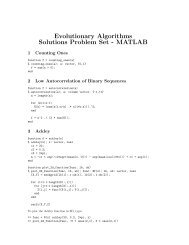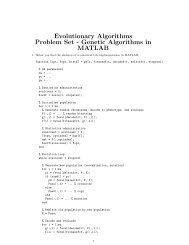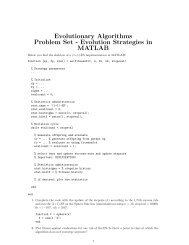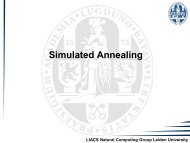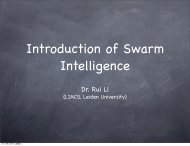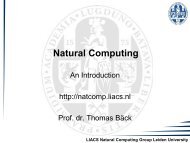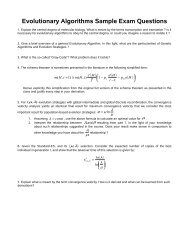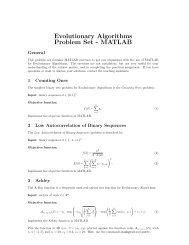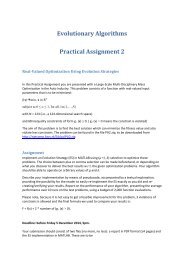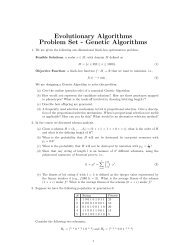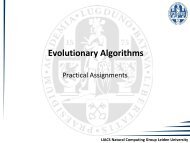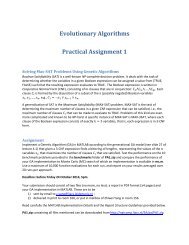Sample thesis 2 - Natural Computing Group, LIACS, Leiden University
Sample thesis 2 - Natural Computing Group, LIACS, Leiden University
Sample thesis 2 - Natural Computing Group, LIACS, Leiden University
Create successful ePaper yourself
Turn your PDF publications into a flip-book with our unique Google optimized e-Paper software.
At some point we decided to fix the largest square at location (0,0) to avoid repeatedly having totranslate our configurations back to some reliable reference location when they would drift off intoregions of 2n where the accuracy of the floating point implementation became questionable.A side-effect of fixing the largest square is a reduction of the state space by 2 dimensions. This gain,however, does not come without any strings attached: The largest square is now not free to move.Although still any configuration of squares can be represented (as they are invariant undertranslation), if some translation of this square or a swap with this square involved would bebeneficial, then the collection of all other squares would need to be adapted instead to attain thesame result. The probability that this would happen by itself is generally much lower than what wewould deem natural. This can be accepted as a drawback, or it can be dealt with pro-actively byimplementing an actual realization of these operations and applying them whenever appropriate, butthe option to implement these features is mildly annoying with the foresight that we will be addingmore complex operations in the future, often experimental, and which would ideally all come withthe appropriate functionality to make up for the static nature of the largest square.With all these things in mind, perhaps fixing the coordinates of a square might not have been thebest choice. However, we would like to argue that given that the choice was made to fix thecoordinates of a square and not provide said functionality, the largest square is at least a betterchoice than the smallest square. Two reasons are firstly the fact that when the largest square moves,on average it has a higher probability than others to overlap (given similar circumstances), andsecondly the special role we have in mind for the smallest square (described in the next paragraph).On the other hand, one might argue the contrary by stating that exactly because the smallest squarehas the lowest probability to overlap other squares (given similar circumstances), it being fixedwould hardly be noticed, especially for larger instances, and would therefore hardly disrupt thefitness landscape.Dimensionality ReductionAnother way to reduce the dimensionality of the problem is to remove the smaller squares,assuming they will fit anywhere and can be put somewhere in the end. We did not implement this ason the other hand small squares don't always have to be in the way and one of the adaptations wewill discuss particularly depends on their presence. The question which set of smaller squares canbe left out for a given number of squares is interesting and non-trivial.We thought it would be interesting to temporarily link touching squares to reduce the problemdimensionality and limit the number of overlaps, but we did not get to implement it.Dynamic Data StructuresA very refreshing idea in the setting of evolutionary strategies, in our opinion, would be to maintaina dynamic data structure with efficient update- and query operations to perform evaluations morequickly. A requirement would be that either the data structure is very lightweight and can be copiedand maintained faster than we can do regular fitness evaluations, or that we can somehow manageour resources such that we can avoid copying the entire data structure time and time again.Matousek [12], which is based on Megiddo's parametric search [13], seems to be a good startingpoint for a dynamic data structure revolving around the smallest enclosing circle problem.A Special Task SquareIt was foreshadowed above that the square with sides of length 1 could potentially fulfill a specialpurpose. For many squares, especially the larger ones, moving them around over larger distanceswould most often result in solutions of very low quality, because of the high probability of beingheavily penalized for overlapping. We could search for locations where a square could fit, if at any



